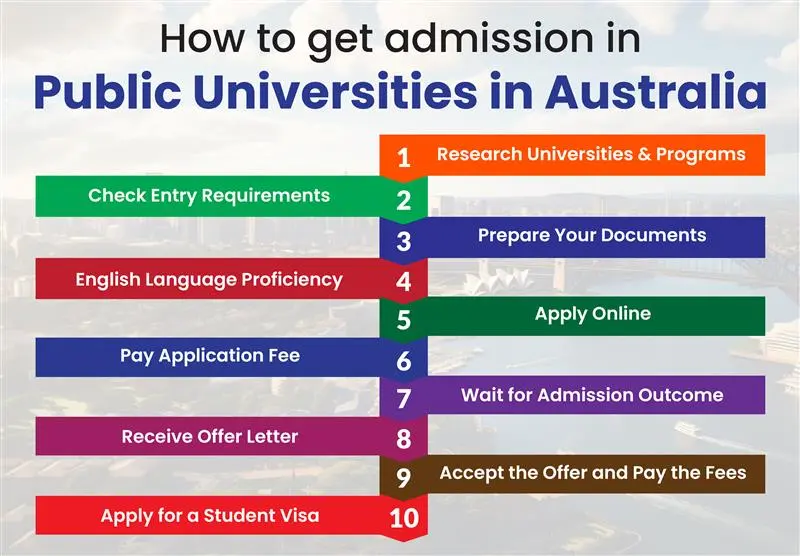If you’ve got an eye for studying in one of the best public universities in Australia, here’s everything you need to know. So, let’s start with why you should choose Australia as your study-abroad destination!
- High Academic Standards
- Global Recognition of Courses
- Most Universities in Australia rank among the top 100
- Up to 6 years Stay Back
- Focuses on Practical Learning
- Wide range of courses
- 48-hour Part-time Work Options/14 days
- High Employability Ratio
- Multiple Intakes
- Family Visa Allowed
Table Of Content
1List of Public Universities in Australia2Best Public Universities in Australia for International Students3Difference between Public and Private Universities4How to get admission in Public Universities in Australia5Conclusion:6Frequently Asked Questions
List of Public Universities in Australia
Here’s a list of all the public universities in Australia:
- Australian Catholic University
- Australian National University
- Charles Darwin University
- Charles Sturt University
- CQ University
- Curtin University
- Deakin University
- Edith Cowan University
- Federation University of Australia
- Flinders University
- Griffith University
- James Cook University
- La Trobe University
- Macquarie University
- Monash University
- Murdoch University
- Queensland University of Technology
- RMIT University
- Southern Cross University
- Swinburne University of Technology
- University of Adelaide
- University of Canberra
- University of Melbourne
- University of New England
- University of New South Wales
- University of Newcastle
- University of Queensland
- University of South Australia
- University of Southern Queensland
- University of Sydney
- University of Tasmania
- University of Technology Sydney
- University of the Sunshine Coast
- University of Western Australia
- University of Wollongong
- Victoria University
- Western Sydney University
Best Public Universities in Australia for International Students
Here’s a list of the top public universities in Australia for international students:
| S.No | University | QS World Ranking 2025 |
|---|---|---|
| 1. | The University of Melbourne | 13 |
| 2. | The University of Sydney | 18 |
| 3. | The University of New South Wales | 19 |
| 4. | Australian National University | 30 |
| 5. | Monash University | 37 |
1. The University of Melbourne
Consistently ranked as a leading public university, the University of Melbourne, founded in 1853, holds the top spot in Australia and has secured outstanding positions globally – 13th in the QS 2025 rankings, 37th in ARWU(Academic Ranking of World Universities), and 39th in THE(Times Higher Education World University Rankings). The university promotes innovation through its 100 research centres and institutes.
| Location |
|
| Popular Courses |
|
| Average Tuition Fees |
|
| Scholarships Offered |
|
2. The University of Sydney
University of Sydney, a public research university, founded in 1850, is the oldest university in both Australia and Oceania. With more than 10 campus locations, the University of Sydney offers a wide range of courses in undergraduate, postgraduate and research programs. Ranking among the top 20 universities globally, this university attracts students and researchers from all over the world.
| Location |
|
| Popular Courses |
|
| Average Tuition Fees |
|
| Scholarships Offered |
|
3. The University of New South Wales
University of New South Wales (UNSW), founded in 1949, is one of the leading public universities in Australia and is known for its strong programs in engineering, technology, business, law, and the sciences. The strong connections with global universities, research institutions, and industries, provide its students with opportunities for international collaborations and student exchanges.
| Location |
|
| Popular Courses |
|
| Average Tuition Fees |
|
| Scholarships Offered |
|
4. Australian National University
Consistently ranked among the top universities globally, this University is regarded as one of the best public universities in Australia. With over 17,000+ students from more than 100 countries, ANU offers a variety of undergraduate, postgraduate, and research programs, making it a top choice for higher education in Australia. As of 2025, ANU is ranked 30th in the world in the QS World University Rankings, and it has maintained strong positions in the Times Higher Education rankings as well.
| Location |
|
| Popular Courses |
|
| Average Tuition Fees |
|
| Scholarships Offered |
|
5. Monash University
Located in Melbourne, Monash University offers more than 100 undergraduate programs and more than 200 postgraduate programs in diverse disciplines. The university emphasizes sustainability, social impact, and community engagement and offers strong support to its international students, including orientation programs, academic support, counselling services, and student clubs.
| Location |
|
| Popular Courses |
|
| Average Tuition Fees |
|
| Scholarships Offered |
|
Difference between Public and Private Universities
Here are some of the key differences between public and private universities in Australia, which include variations in funding sources, tuition fees, academic offerings, research focus, and class sizes, shaping the way education is delivered.
| Aspect | Public | Private |
|---|---|---|
| Funding | Government-funded | Primarily funded by tuition fees and private sources |
| Tuition Fees | Generally lower | Higher for domestic and international students due to lack of government funding. |
| Government Support | Receives significant government funding and subsidies | Limited or no government funding |
| Student Population | Large, diverse student body | Smaller, more niche student populations |
| Course Offerings | Wide range of courses across various disciplines | Focuses on specific fields, often with smaller offerings |
| Reputation | Often globally recognized and ranked | Reputation may vary, but some are well-regarded |
| Research Opportunities | Strong research programs and funding | Less emphasis on research, and more on teaching |
| International Students | Popular choice for international students | Attracts fewer international students |
How to get admission in Public Universities in Australia
Getting admission to public universities involves several steps:
1. Research Universities and Programs
Start by researching the public universities in Australia and the courses you prefer to pursue, and consider factors like location, course content, and entry requirements.
2. Check Entry Requirements
Review specific entry requirements, academic qualifications, English language proficiency, and other necessary prerequisites for your preferred program. The requirements can vary depending on the program, so make sure to check the university website for more accurate information.
3. Prepare Your Documents
Prepare all the necessary documents for your application like academic transcripts and certificates, English language proficiency test scores, Statement of Purpose (SOP) or personal statement, letters of recommendation, passport copy etc.
4. English Language Proficiency
Most universities in Australia require proof of English language proficiency. Take an English proficiency test like IELTS, TOEFL, or PTE (Pearson Test of English) if required. Check the university websites for more specific score requirements.
5. Apply Online
Almost every Australian university has an online application portal where you can apply for admission. Start by creating an account and then submit your application, along with all the necessary documents.
6. Pay Application Fee
Many universities require a non-refundable application fee when submitting your application but there are exceptions where you don’t even have to pay the application fees. Make sure you keep the receipt for future reference.
7. Wait for Admission Outcome
After you have submitted your application, it typically takes around a few weeks to process and review your application. Meanwhile, you will receive notifications of your application’s progress or be invited for an interview depending on the course requirements.
8. Receive Offer Letter
You will receive an offer letter after you have been accepted into the university. The letter outlines the terms and conditions of your admission and any requirements for you to fulfil such payment of your tuition fees.
9. Accept the Offer and Pay the Fees
You will need to formally accept the offer, after which you will need to pay the tuition fees or any deposits that are required. Upon payment, you will receive a Confirmation of Enrolment (CoE) document, which you would require to apply for your Australia Student Visa.
10. Apply for a Student Visa
Submit the necessary documents for an Australian Student Visa (Subclass 500) including proof of financial support, health insurance (Overseas Student Health Cover or OSHC), and a valid passport. Once your application has been processed, you will receive your visa and can start making travel arrangements.
For more details on how to and when to apply, connect with CanApprove.
Conclusion
Australia is home to some of the world’s best public universities. These universities not only provide strong academic programs but also offer comprehensive student support services, vibrant campus life, and access to a vast network of alumni and industry connections.
Choosing the right university depends on factors like program offerings, location, campus facilities, and personal preferences. CanApprove can help with all these, guiding you through the process. As your trusted study abroad partner, we are committed to helping you make informed decisions and achieve your educational goals.






